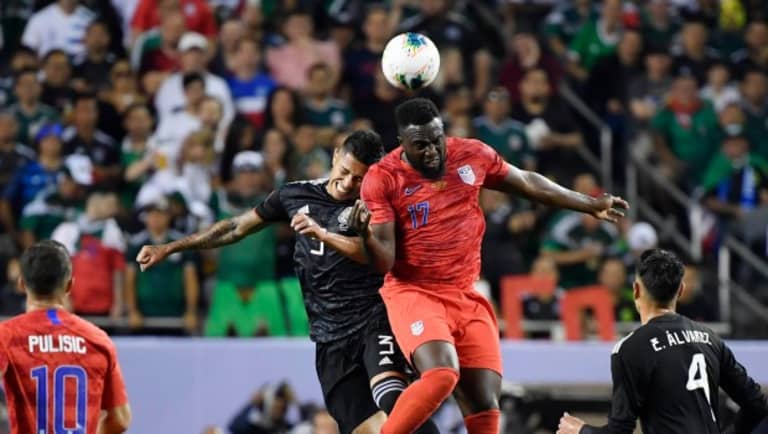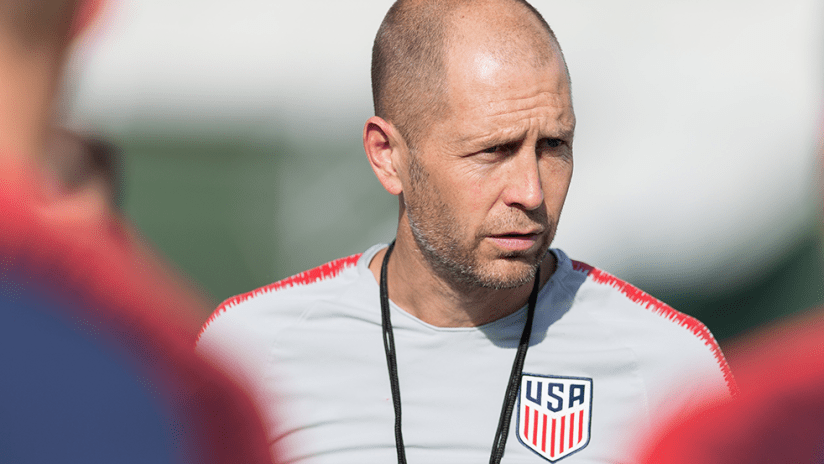“Looking back on it, it seems like it's been more than a year. But the team is certainly in a good spot right now.”
Those were the words of US men’s national team head coach Gregg Berhalter as he discussed Saturday's friendly (3:55 pm ET | ESPNews, UniMas, TUDN) against Costa Rica in a conference call with reporters on Monday. The remarks also came one year and a day after his first match in charge of the USMNT, a 3-0 win over Panama at the same point in the 2019 January camp.
So are they really “in a good spot”? The next 12 months of his tenure figure to be more eventful, and a lot more meaningful in competitive terms, as the Under-23s fight for a place at the Olympic Games in Tokyo and the full squad wades into 2022 World Cup qualifying in late summer.
First, a few numbers and thoughts on Berhalter's first year, starting with the raw on-field results:
- Overall record of 11-5-2; 38 goals scored, 14 conceded
- 8-2 in competitive matches; 5-1 in Concacaf Gold Cup action, 3-1 in Concacaf Nations League play
- 3-3-2 in friendlies, including a 3-0 loss to Mexico and a 1-0 loss to Jamaica
- 1-1 in two away matches; the rest were played on home soil
Dogma vs. pragmatism
This is one of the longstanding challenges for any USMNT coach in the modern era: How to balance results and aesthetics, especially given the profoundly unbalanced realities of the Concacaf region? How can the need for ruggedness coexist with the oft-stated goal of evolving towards a more proactive, possession-friendly playing style?
Berhalter espoused big ideas and ambitions when he took the job at the end of 2018, coining a phrase that he would utter at least a dozen times over the ensuing year: “The idea is that we’re an attacking-based team that wants to create goal-scoring opportunities by disorganizing the opponent.”
He told Yahoo Sports that “there’s nothing I can envision more than playing against a big team and unbalancing them, hurting them, making them chase the ball. If we can stick to positional principles, and we can execute in one, two touches, we will be able to do some damage.”
It’s an old question, and we got some of the same old answers in 2019. The USMNT beat most of the teams they were supposed to beat, with the exception of underwhelming losses to Jamaica (an experimental Gold Cup warmup) and Canada (an ugly Nations League loss in Toronto). And of the few opponents above them in the FIFA World Rankings, they didn't knock off many, losing twice to Mexico and holding serve in friendly draws vs. Chile and Uruguay.
Berhalter’s teams generally dictated terms against the underdogs and had to scrap to keep pace with higher-level teams. And in two of their worst performances (3-0 friendly thumpings from Venezuela and Mexico), they were plodding and error-prone as Berhalter made a point to press his build-up agenda in spite of immediate circumstances being unfriendly to it.
When his team absolutely, positively had to bag a W – arguably only the Gold Cup final vs. El Tri and the pivotal CNL group decider vs. Canada in Orlando – the coach relented, and some of the Yanks’ best moments in both matches came from direct play. Expect this push-pull to continue well into 2020.
Depth, and the lack thereof
In his year-end USMNT wrap, our very own Matthew Doyle emphasized the “donut hole” aspect of the current player pool, writing that the “lack of prime-aged players is still the defining aspect of this US roster.” And at times it’s seemed that Berhalter agrees, as he’s kicked the tires on a range of right-now options and rising up-and-comers.
“Looking back at a year's work, one thing’s for sure,” he said on Monday. “We have a very good understanding of the player pool, and looking at the strengths of the player pool, understanding the group. We've looked at a lot of players over this last year, we've gotten to see a lot of them in camp. And it's been a great process.”
The US, in general terms, have good competition at goalkeeper, central defense and right back, and at least something approaching that in central midfield. They could use a few more options on the wings, traditionally a key area of the attack in Berhalter’s teams.
Left back remains perennially problematic. They’re hard up at the No. 9 role – “We don’t have a lot of depth in that position, it is a position of need,” the coach himself observed as he defended his faith in the polarizing Gyasi Zardes, who tends to be reliable against second-tier opposition, less so against the elites. Jozy Altidore is fearsome and battle-tested, but frustratingly injury-prone. Josh Sargent is a top talent in a top-caliber environment at Werder Bremen, yet remains a teenager, still mastering his trade. The promising youngsters in camp this month are still just that, especially at this level.
This might be the program’s biggest concern right now: It’s rarely clear at any given time which proven goalscorer, if any, will be in form and available for selection.
Culture, culture, culture
This one is the hardest to quantify, and proof of it often doesn’t become clear until after the fact. The multiple faceplants of the 2018 qualifying cycle gave the strong impression that, in contrast to the strong spirit and cohesion of past editions, the USMNT were no longer consistently greater than the sum of their parts.
For his first USMNT gathering, last year’s January camp, Berhalter selected the remote environs of the Olympic Training Center in Chula Vista, Calif., for a traditional “retreat” vibe. It was aimed at the group being immersed in both his tactical concepts and their own cultivation of unity and a collective identity. That process continued to earn emphasis this time around, even with political events in the Middle East forcing a last-minute abandonment of the plan to set up shop in Qatar, home of the next World Cup.
“Guys are getting their feet wet, they're understanding – more importantly than how we play on the field, what is the culture like in this group? How do you come to practice every day ready to compete?” explained center back Walker Zimmerman this week.
“One of conversations that we had was it feels like we've progressed so much more with how we started this January than last January. Just with people understanding the concepts and ideas that we’re trying to build, again the culture of being a collective team and a family. So I think this year guys are progressing a little bit faster, picking up on concepts a little bit faster, and that’s helped us.”

Despite clarity at some positions, the US men's national team still largely doesn't have a penciled-in striker | USA Today Sports
Berhalter has projected a similar tone, even while admitting that the team fell well short of expectations in this category during some of their worst moments this year, such as the passive, plodding performance in Canada.
“We feel like the group has made strides. We feel like the group is more mature now. And when we integrate younger players into it, it's a seamless transition because the culture of the team is strong,” Berhalter said this week.
We’ve also been told that this is an area of focus for retired legend Brian McBride, who recently came on board as general manager and has been tasked with instilling and maintaining a collective pride and identity across the federation’s men’s teams.
Much of the fanbase has harbored a simmering general discontent since the woes of 2017, a headwind that greeted Berhalter upon arrival in his post through no fault of his own. Much of that can only be dispelled by a successful 2022 qualification campaign, but in the meantime, the USMNT staff's looking to control the controllables.
Once the Hex begins, however, results become the sole barometer of success. And the USMNT have only a precious few camps between then and now to get things right.














